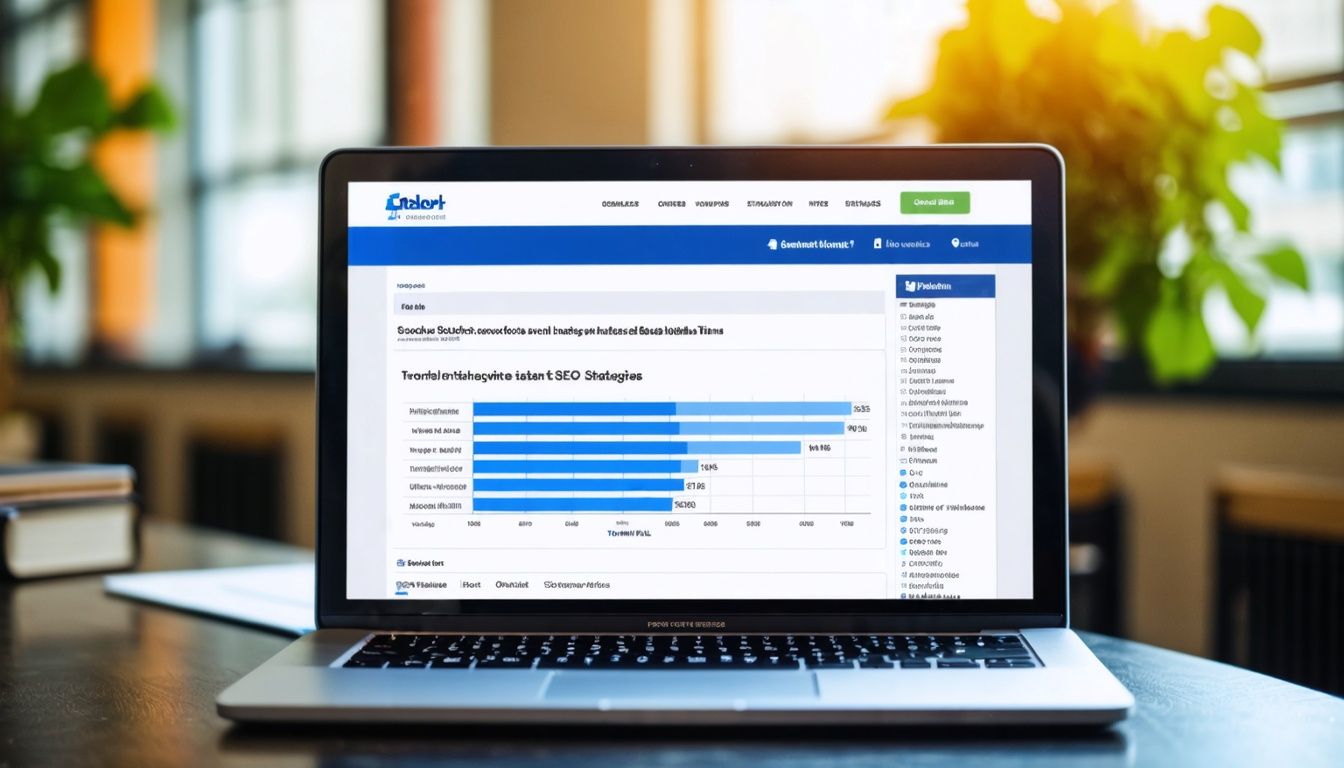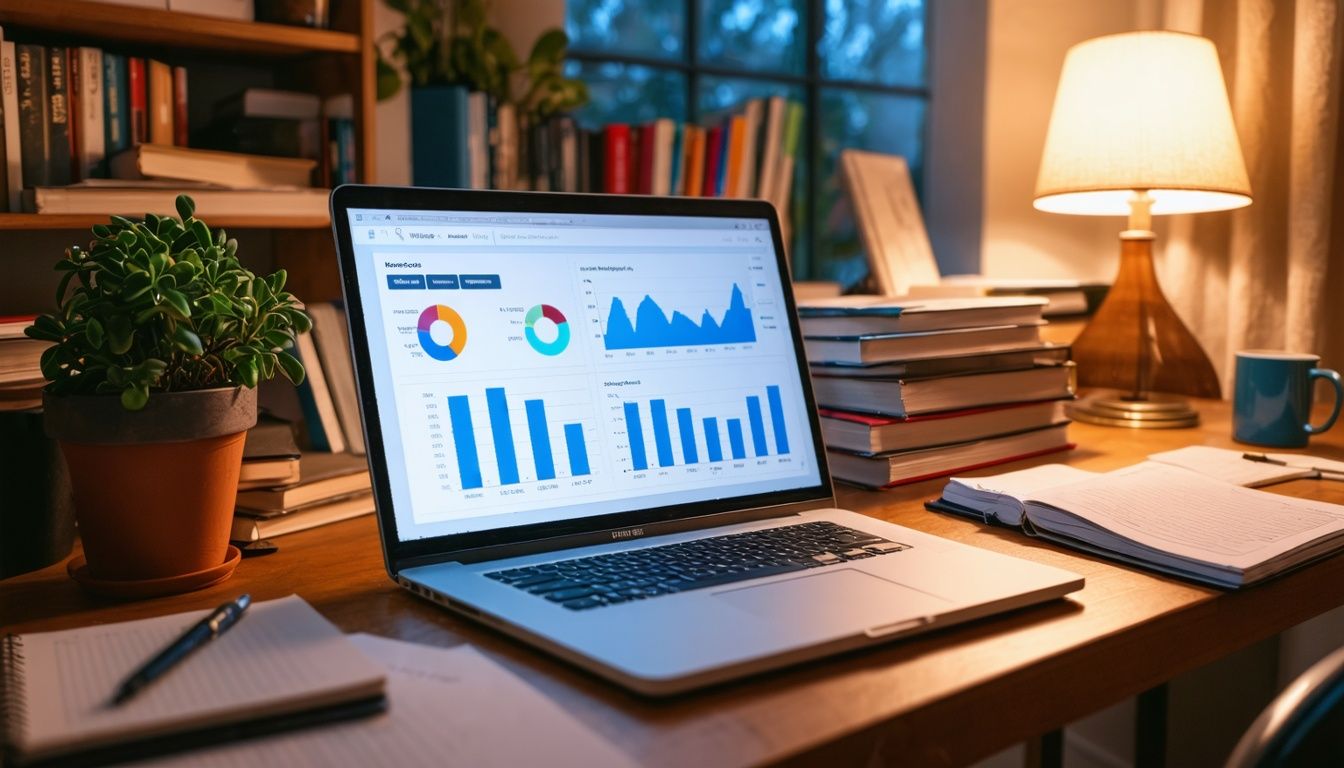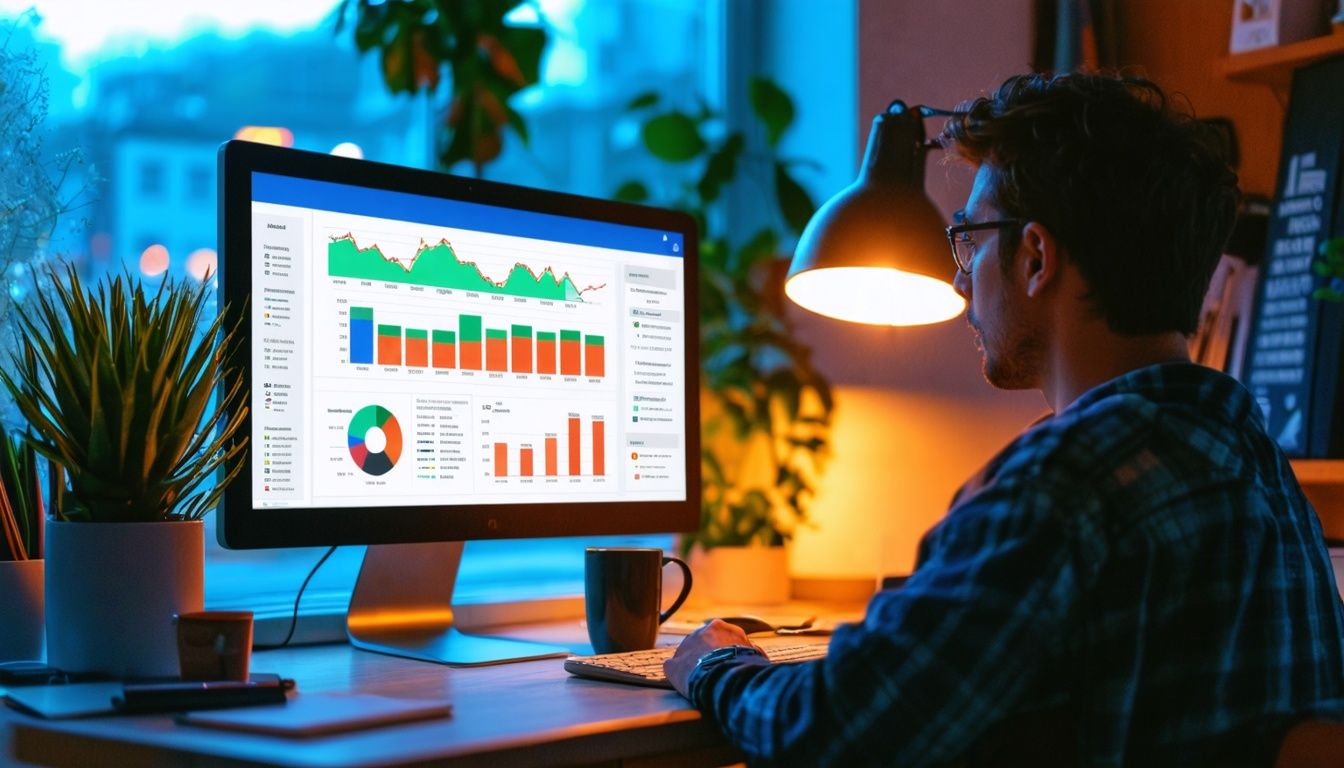Latest Google SEO Strategies Revealed


Are you struggling with getting your website noticed in Google search results? Google’s latest SEO strategies can help improve your site’s visibility. This article will guide you through the newest tips and tricks to boost your ranking.
Keep reading to unlock better search engine optimization for your site!
Understanding Google’s Algorithm Updates

Google frequently updates its algorithm to improve search results. These changes impact how websites are ranked and perceived by users and crawlers.
Overview of recent updates

March 2024 saw a core update that took 45 days to complete. This change affected many websites’ Google ranking positions, impacting their organic traffic. December 2023 included an “openness” local search update which aimed to enhance how local businesses appear on search engine results pages (SERPs).
The November 2023 reviews update focused on improving the quality of review content.
October 2023 introduced a significant spam update designed to combat black hat SEO techniques and spamming practices. In May 2023, the topic authority system was updated, refining how crawlers assess page expertise and trustworthiness.
August 2023 delivered another core algorithm adjustment affecting page rankings across various niches.
SEO is like a resume, you polish it so you have your best foot forward.
Impact of updates on SEO practices

The recent updates to Google’s algorithm have dramatically impacted SEO practices. The March 2024 core update, for example, slashed unhelpful content by a staggering 45%. This forced digital marketers and SEOs to prioritize high-quality content that genuinely helps users.
Core updates can take up to a month to complete, meaning websites might see significant changes in their search engine rankings over time.
These algorithm changes led many companies to reevaluate their SEO strategies. Multiple businesses experienced fluctuations in traffic and revenue as Google indexed new content based on the latest criteria.
Following industry experts like Marie Haynes and Barry Schwartz became crucial for staying informed about best practices. Staying adaptable helped SEOs manage shifts effectively, ensuring that they remained competitive in an ever-evolving online landscape.
Key SEO Strategies Post Latest Updates

Focus on improving your website’s credibility by emphasizing expertise and trustworthiness. Ensure your site loads quickly and is optimized for mobile devices to attract more visitors.
Optimizing for E-E-A-T (Expertise, Experience, Authoritativeness, Trustworthiness)

Creating content with strong E-E-A-T enhances your page’s credibility. Expertise means showcasing that the author knows their field well. Experience comes from demonstrating practical, hands-on knowledge in the subject matter.
Authoritativeness reflects the respect and recognition from other sites and entities like Google News or online communities. Trustworthiness focuses on giving users reliable, factual information that they can depend on.
High-quality content should be easy-to-read, organized, unique, up-to-date, helpful, and focused primarily on people. Sites need to avoid keyword stuffing while writing useful articles and blog posts that answer user queries accurately.
Using authoritative sources bolsters trustworthiness. Follow best practices for search engine optimization (SEO) by making sure mobile devices display your site correctly.
Trust builds slowly but falls rapidly.
Importance of high-quality content
High-quality content holds immense value for any website. Engaging and useful posts make a site interesting to users, boosting overall page views and time on page. Google often rewards compelling content with higher search rankings, improving discoverability.
Using relevant keywords like “Google algorithm” or “SEO strategy” in your articles can enhance the site’s performance in search results.
Avoid overly distracting ads as they can frustrate visitors and increase bounce rates. Instead, link to valuable resources that provide additional information aligned with user intent.
This not only enhances the user experience but also helps search engines understand how your content fits within the broader web ecosystem. Employing these practices ensures consistent traffic while meeting Google’s latest SEO standards.
Mobile optimization
Mobile optimization is crucial for SEO success. Google’s latest updates emphasize its importance. Websites must be user-friendly on smartphones and tablets to rank well in search results.
Google’s algorithm favors sites optimized for mobile, affecting their page ranking.
Ensure fast load times and a responsive design that adapts to different screen sizes. High-quality images compressed for quicker loading can also improve mobile performance. Mobile optimization isn’t just about looks—it’s essential for better engagement, higher click-through rates, and improved reputation online.
Prioritize this aspect of SEO strategies to stay ahead in Google searches.
Enhancing Site Structure for Better SEO

A well-organized site structure makes it easier for search engines to crawl and index your pages. Use clear, descriptive URLs to improve user experience and rankings.
Using descriptive URLs
Descriptive URLs improve user experience and search engine understanding. They give a clear idea of the page content, which helps users decide if the link meets their needs before clicking.
This boosts click-through rates and reduces bounce rates.
Grouping topically similar pages enhances clarity for both users and crawlers. For example, using “example.com/seo-tips” instead of “example.com/page1” aids in better indexing by Google algorithms.
As a result, your site ranks higher on Search Engine Results Pages (SERPs).
“A good URL is like a great headline; it tells you exactly what to expect.”
Organizing content thematically
Using descriptive URLs is crucial, but organizing content thematically truly enhances user experience. Grouping related information together makes it easier for visitors and search engines to understand the site’s structure.
This method helps Google crawl the web more efficiently. For instance, a website about digital marketing could categorize content into “SEO Tips,” “Content Marketing Strategies,” and “Social Media Platforms.”.
Reducing duplicate content also improves site organization. Canonical URLs help prevent issues with repeated material by specifying which version of a page should appear in search engine results pages (SERPs).
High-quality, thematic organization signals trustworthiness and expertise to both users and search engines, boosting overall pagerank.
Reducing duplicate content
Organizing content thematically can improve your SEO, but reducing duplicate content also plays a vital role. Duplicate content affects user experience and uses up search engine crawling resources.
To avoid this, use canonical tags to highlight the preferred version of web pages. Create descriptive URLs unique for each page.
Evaluate site structure regularly to spot and remove any duplication errors promptly. Use SEO tools like Google Analytics or SEMrush to identify duplicate issues quickly. High-quality writing should be original and provide real value to readers, minimizing the chance of repetition across different pages of your website.
Advanced On-Page SEO Techniques

Optimizing title tags and meta descriptions can significantly boost your search engine rankings.
Optimizing title tags and meta descriptions
Title tags and meta descriptions play key roles in shaping how a site appears in Google search results. Craft title tags that are clear, concise, and less than 60 characters to ensure they fit well on the search engine results pages (SERPs).
Include primary keywords close to the beginning of the tag for better visibility.
Meta descriptions should complement title tags by providing a brief summary of what users can expect from your content. Aim for about 160 characters to avoid truncation. Use compelling language that encourages clicks without being misleading.
This improves both click-through rates and user engagement, leading into strategic use of headers and subheaders next.
Strategic use of headers and subheaders
Title tags and meta descriptions draw users to your content, but headers and subheaders keep them engaged. Headers (H1, H2) and subheaders (H3, H4) break content into manageable sections.
This structure improves readability and helps search engine crawlers understand the page’s hierarchy. Descriptive headers guide readers through the main points while boosting SEO.
Each header must reflect the topic of its section clearly. For instance, using structured keys in “Optimizing Title Tags” makes it clear what readers will learn next. Effective use of headers can also incorporate keywords seamlessly, enhancing Google rankings without keyword stuffing.
Ensuring systematic usage enhances mobile optimization by making your site more scannable for users on smaller screens.
Importance of image and video optimization
Headers and subheaders improve readability, but images and videos add another layer of user engagement. High-quality images should be placed near relevant text with descriptive alt text to enhance accessibility and SEO.
Including key phrases like “alt attribute” in alt texts helps Google understand the image content, boosting your site’s search engine results.
Optimizing videos is essential for better rankings. Videos need high-quality content and dedicated pages with clear titles and descriptions. Using keywords such as “youtube,” “img element,” and “visualizations” in video titles boosts visibility on platforms like YouTube, enhancing your overall digital strategy.
The Role of Artificial Intelligence in SEO

Artificial Intelligence is transforming how sites rank on search engines. It helps in analyzing patterns and predicting trends for better SEO strategies.
How AI is shaping SEO strategies
Google’s AI, such as RankBrain and BERT, helps improve search results by understanding user intent. These tools analyze queries more accurately, matching them with relevant content.
AI focuses on boosting the quality of navigation within websites and elevating the overall user experience. It emphasizes E-E-A-T (Expertise, Experience, Authoritativeness, Trustworthiness), prompting webmasters to prioritize high-quality content.
AI also identifies low-quality or spammy SEO practices quickly. During Google’s updates in October and November 2023, sites using poor-quality AI-generated content experienced a massive drop in organic traffic.
To stay competitive, it’s essential to monitor your site’s data closely after each Google update and make necessary adjustments based on insights from these changes.
Tools and technologies for AI integration
Artificial intelligence is revolutionizing how SEO strategies are developed and executed. Several tools and technologies can help integrate AI into your SEO practices effectively.
- Google Search Central LinkedIn Account
The new LinkedIn account offers valuable news and resources. It helps you stay updated on making your website more discoverable.
- SEO Starter Guide
This guide assists website owners in improving their site’s visibility. AI tools within the guide make content creation and optimization simpler.
- Machine Learning Algorithms
These algorithms analyze vast amounts of data to predict user behavior. They enhance keyword research and identify trends that improve search rankings.
- AI-Generated Summaries
Tools like HubSpot use AI to create summaries for long articles. This makes content easier to read and improves user engagement.
- Natural Language Processing (NLP)
NLP technologies understand and process human language naturally. They ensure your content matches what users are searching for online.
- Image Recognition Software
Tools such as Google Images use AI to analyze and tag images accurately. This boosts image search optimization on your site.
- Chatbots with AI
Integrating chatbots improves customer experience by providing instant responses to queries, which keeps users engaged longer on your site.
- Content Optimization Platforms
Platforms like Clearscope use AI to help optimize content for readability, relevance, and SEO performance based on competitor analysis.
- Automated Meta Tagging Tools
These tools generate meta tags automatically, ensuring all pages have unique tags optimized for relevant keywords.
- Voice Search Optimization Services
As voice search grows, AI tools help tailor content suitable for voice queries, increasing your site’s chances of appearing in voice search results.
Implementing these tools aids in staying competitive with the latest Google algorithm updates while making your SEO strategy more efficient and effective.
Building and Maintaining Site Authority

Creating high-quality backlinks is essential for boosting your site’s authority. Enhance reputation by engaging with thought leaders and influencers in your industry.
Link building strategies
Link building is crucial for improving your site’s authority. It helps in achieving better search engine rankings by increasing the number of quality backlinks to your website.
- Broken Link Building
Identify broken links on other websites. Contact the site owner and offer your link as a replacement. This method benefits both parties: you get a new backlink, and the site owner fixes a broken link.
- Competitor Analysis
Use tools like SEMrush to analyze competitors’ backlinks. Identify where their links come from and reach out to those sites to request similar backlinks.
- Guest Blogging
Write high-quality articles for reputable blogs in your niche. Include a link back to your site within the content or author bio.
- Evangelist Method
Build relationships with influencers and subject matter experts who can mention or link to your site. Share their content, engage with them on social media, and eventually pitch your ideas for collaboration.
- Resource Page Link Building
Search for resource pages related to your industry or niche. Reach out to the owners of these pages and suggest adding your site as a valuable resource.
- Reciprocal Links
Exchange links with related but non-competing websites. Both sites benefit from increased traffic and improved SEO rankings.
- Content Marketing
Create and share engaging content such as infographics, comprehensive guides, or research studies that others find valuable enough to link back to.
- Directory Submissions
Submit your website to reputable directories like DMOZ or BOTW.org for an easy way to gain trusted backlinks.
- Social Media Engagement
Share your content on platforms like Twitter, Facebook, Instagram, Pinterest, Reddit, Bing, WhatsApp, and Google+. Engage with users through comments and shares to increase visibility and attract natural backlinks.
- Forum Participation
Participate in forums relevant to your niche by contributing valuable insights and linking back to relevant pages on your site where appropriate without spamming.
Managing and enhancing site reputation
Maintaining a strong site reputation requires addressing real user needs. Build your brand by focusing on genuine interactions and high-quality content. Google values websites that users trust, so avoid spam links and link farms.
Regularly monitor data for problems that arise from updates to maintain authority. Using tools like Google’s Manual Action report page can help you spot penalties early.
Diversify traffic sources through pay-per-click ads, email campaigns, social media referrals, and organic SEO efforts. This reduces the impact of sudden algorithm changes on your site’s performance in search engine results pages (SERPs).
Check your site’s backlinks regularly using the Disavow Links tool to ensure no harmful links affect your ranking negatively.
Monitoring SEO Performance

Use tools like Google Analytics to track your SEO progress. Analyze data regularly to spot trends and areas for improvement.
Tools for tracking SEO progress
Tracking your SEO progress is crucial for understanding the effectiveness of your strategies. Several efficient tools can help you monitor and improve your website’s performance.
- Google Analytics:
- Provides comprehensive data on visitor behavior.
- Tracks metrics like bounce rates, session durations, and traffic sources.
- Helps identify which content performs best.
- Google Search Console:
- Monitors site health and search performance.
- Reports on crawling issues and indexing status.
- Shows keywords that drive traffic to your site.
- SEMrush:
- Offers insights into organic search positions.
- Analyzes competitors’ strategies and backlinks.
- Tracks keyword rankings over time.
- Ahrefs:
- Provides a detailed backlink profile analysis.
- Displays top-performing pages based on organic traffic.
- Monitors rank changes for targeted keywords.
- Moz Pro:
- Features a robust keyword research tool.
- Tracks local rankings for mobile searches.
- Alerts you of critical SEO issues that need fixing.
- Screaming Frog SEO Spider:
- Crawls websites to find broken links and duplicate content.
- Generates sitemaps to improve site structure.
- Identifies areas needing optimization for better page performance.
- Serpstat:
- Offers rank tracking with historical data comparison.
- Conducts in-depth website audits covering various SEO factors.
- Analyzes PPC campaigns alongside organic search efforts.
- Ubersuggest:
- Tracks keyword positions daily.
- Suggests new content ideas based on searched terms.
- Audits websites for technical improvements.
Using these tools will help ensure that your SEO efforts are on track, enabling ongoing enhancements tailored to achieve higher search engine rankings and better user engagement.
Analyzing and interpreting SEO data
Analyzing and interpreting SEO data is crucial to improving your website’s performance. Use tools to track and understand key metrics for adjusting strategies effectively.
- Conduct Website Audits:
- Scan for broken links, slow loading pages, and other technical issues.
- Identify areas that might affect site visibility on search engines.
- Utilize tools like Google Analytics and SEMrush to find these problems.
- Track Search Engine Results Pages (SERPs):
- Monitor your rankings on SERPs to see how often your site appears.
- Track keyword performance using search index tools.
- Evaluate Organic Traffic:
- Measure the amount of visitors coming from organic searches.
- Look at trends over time to spot any drops or spikes in traffic.
- Use Heatmaps:
- See where users click on your pages with heatmap tools like Hotjar.
- Understand user behavior to improve page design and navigation.
- Analyze Bounce Rate:
- Check the rate at which users leave after viewing one page.
- High bounce rates may indicate content isn’t meeting visitor expectations.
- Monitor Click-Through Rates (CTR):
- Measure how often users click on your site’s link in SERPs compared to the number of times it appears.
- Low CTRs suggest that meta descriptions or titles need improvements.
- Check Backlinks:
- Review the quality and quantity of sites linking back to yours using tools like Ahrefs.
- Quality backlinks help boost domain authority and improve rankings.
- Examine On-Page SEO Metrics:
- Assess title tags, meta descriptions, headers, image alt texts, etc., for optimization opportunities.
- Measure Page Load Speed:
- Use Google PageSpeed Insights to check loading times on desktop and mobile browsers.
- Faster pages rank higher as they provide better user experience.
- Understand User Engagement Metrics:
– Look at metrics such as session duration and pages per session in Google Analytics.
– Higher engagement indicates valuable content keeping visitors interested.
- Utilize Data Visualization Tools:
– Tools like Google Data Studio transform complex data into visual formats making easier interpretation of results.
Efficiently analyzing this data enables you to adapt your strategy continuously, ensuring that your SEO efforts yield significant returns while staying aligned with Google’s frequent updates.
Preparing for Future Google Updates

Stay updated on Google’s potential changes by subscribing to SEO newsletters. Adapt your strategies quickly to maintain and improve search rankings.
Staying informed about potential updates
Google constantly changes its search algorithms, with 4,725 updates in 2022 alone. Check the Google Search Central blog regularly for news on algorithm tweaks and their effects on SEO.
Their LinkedIn and Twitter accounts provide timely alerts about significant shifts. For more detailed guidance, follow Google’s Help Forum and YouTube Channel which offer expert advice from SEO content specialists.
Use these channels to track updates that can impact your web design or search engine results pages (SERPs). Staying informed helps you adjust strategies quickly to maintain or improve your rankings.
Use tools like bookmarks to save essential resources and domain names relevant to your industry, ensuring you are always one step ahead of potential disruptions.
Adapting strategies in response to changes
Adapting SEO strategies after an algorithm update is essential. Algorithm updates by Google often impact rankings, traffic, and revenue significantly. Observing the changes post-update helps identify any drop in search engine results pages (SERPs).
Follow advice from experts like Marie Haynes or Barry Schwartz to analyze the impact effectively.
Implementing new strategies based on these observations can aid recovery. Enhancing high-quality content and improving mobile optimization can mitigate risks from such updates. Use tools for tracking performance regularly to assess recovery progress and refine your approach accordingly.
Conclusion

Google’s latest SEO strategies are game-changers. Focus on E-E-A-T to boost your site’s credibility. Create high-quality content and optimize for mobile users. Use AI tools to refine your SEO efforts.
Stay updated on Google’s changes to keep ahead in search rankings.






Leave a Reply